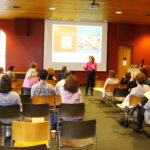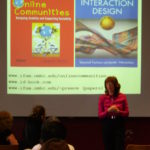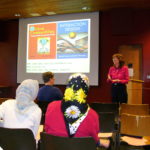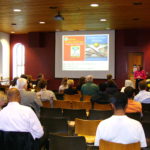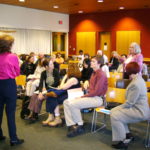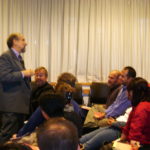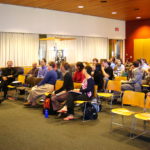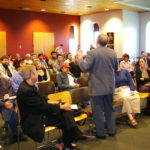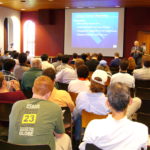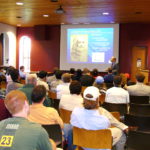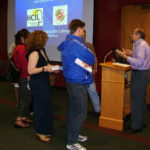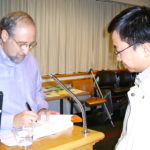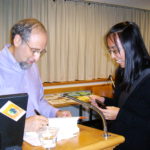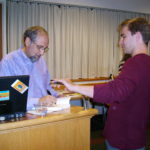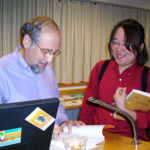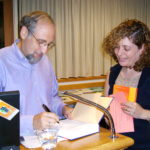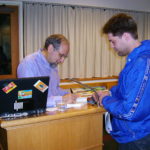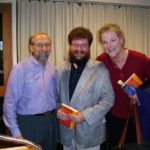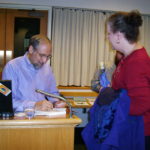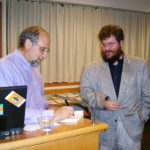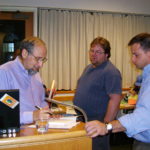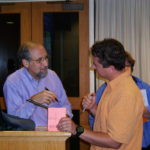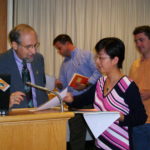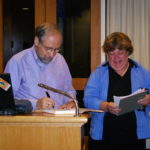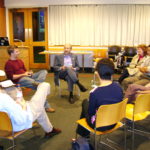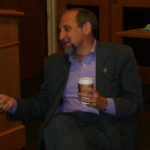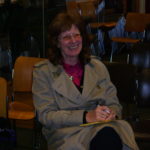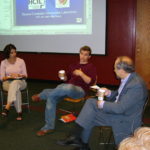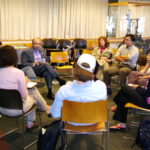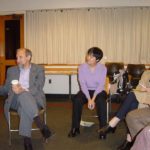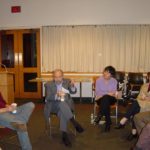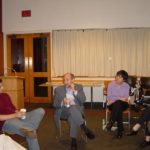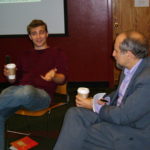Drs. Jenny Preece and Ben Shneiderman spent two evenings and one whole day on Syracuse University campus. They gave two well attended presentations, talked to faculty members from all over the campus, had meals with IST faculty members and the Dean, and spent valuable time with School of Information Studies doctoral students on their research projects. Ben also signed his recent book for the audience.
This webpage maintains some of the relevant information, Ping’s introductions of Ben and Jenny to the SU community, and some photos taken during their visit.
About the ISI Samuel Lazerow Memorial Lecture Program
The Institute for Scientific Information (Thomson ISI) helps universities support lectures in the field of Information Science (broadly defined). All Lazerow Lectures sponsored by ISI are organized by a school of library/ information science at participating colleges and universities. This is the first time Syracuse University School of Information Studies has hosted Lazerow lectures in its 22 years history. We are very fortunate to have two extremely well known leaders in the field of Human-Computer Interaction to give the lectures.
Introducing Dr. Preece by Ping
Jenny is currently a professor of information systems at the University of Maryland, Baltimore County, where she was department chair for almost six years. She moved to US about 7 years ago from England where she established herself as an influential, famous and profound scholar in the HCI community. Her current research focuses on online communities.
Jenny is an amazingly productive author of eight books including: Human-Computer Interaction (1994), Online Communities: Designing Usability, Supporting Sociability (2000), Interaction Design: Beyond Human-Computer Interaction (2002).
Before I knew Jenny in person, I read quite a bit of her work in the HCI area. Her book I am most familiar with is the Human-Computer Interaction published in 1994. I literally chewed on the book words by words! To me, this is the bible of HCI that introduces me the entire HCI field in a coherent fashion. Over several years since I first read and then used the book in my HCI classes, I felt that I knew Jenny very well through this book. So last year, when I was organizing the first annual workshop for HCI research in MIS, that was held before the International Conference on Information Systems (ICIS) in Barcelona Spain, it was naturally occurring to me that I should invite Jenny as my guest speaker, even though Jenny did not know who I was at all. I have been so thankful that I was very brave and sent out the invitation. Besides the fact that Jenny did become my guest speaker to show her strong support, I got the opportunity to know the true and real Jenny, the extremely kind, generous, and remarkablely smart scholar, a wonderful friend and a great colleague. Jenny is a legend who contributes a great deal already and is still contributing to the HCI field.
For more information on Jenny, visit her homepage.
Introducing Dr. Shneiderman by Ping
Due to Ben’s amazing achievement and being a true legend, one can easily get very intimidated by such a big name. I remember I first emailed Ben around 1994 when I was doing my dissertation research on information visualization. There were only a few research studies done at the time and among them were Ben’s work. So I emailed Ben to inquiry his work. I got a reply with such details that took almost 4 pages long. I thought at the time, maybe one of his assistants sent out the email that was so detailed to a doctoral student. Now after knowing Ben, I am sure Ben did it himself. I still remember the first time I saw him in person. It was at the ACM Workshop on New Paradigms in Information Visualization and Manipulation, December 1995, Baltimore, the year I started as an assistant professor at SU. Ben was giving a talk, and I was sitting in the audience, all excited about finally seeing such a famous person in my own eyes. During the break after Ben’s talk, I was too shy to step forward to say hello to Ben – then I was so regretful after Ben left!
So you can imagine how delighted and excited I was when Ben agreed to be my guest speaker at the first annual workshop on HCI in MIS that I organized last year in Barcelona. Most importantly, I got the opportunity to know Ben. He is not so intimidating after all. As a matter of fact, he is so down to earth that sometimes it feels that he is more like an uncle than a legend. He is such a wonderful human being who is extremely kind, generous, and supportive, and has such a great open mind.
Like many others, I have been truly amazed by his visionary thinking that no others can top. If you get a chance and read his work in the 70s, 80s, and 90s, you will see that they were so true, so insightful, so still relevant and you cannot help but wonder how could such wonderful ideas come up at that time by a human not a god? Ben’s work has touched every person who uses computers in so many ways.
As just one example, You may be all familiar with a notion called “direct manipulation” that is the foundation of today’s user interface (GUI Graphic User Interface) where you can use a mouse to manipulate objects on the interface as if you would manipulate a physical object in the real world. Ben published the idea in 1982 in the paper entitled “The Future of Interactive Systems and the Emergence of Direct Manipulation,” in the journal Behaviour and Information Technology. In that paper, he claimed that “this is an approach that promises to become widely used in interactive systems.” As we can all testify, this idea has been around for more than 20 years, has supported many of us since the early days we interacted with computers, and is still with us as of today!
As another example, in 1983, he pioneered the highlighted textual link, and it became part of Hyperties, which was a precursor to the Web. And now as of today, few people I know or you know can live without the Web.
Ben is always on the very front end of the wave, and thus always has so many followers. Today, he is going to present us a new vision of computing. This is also the key point of the book he would be signing after the talk.
For more information on Ben, visit his homepage.
